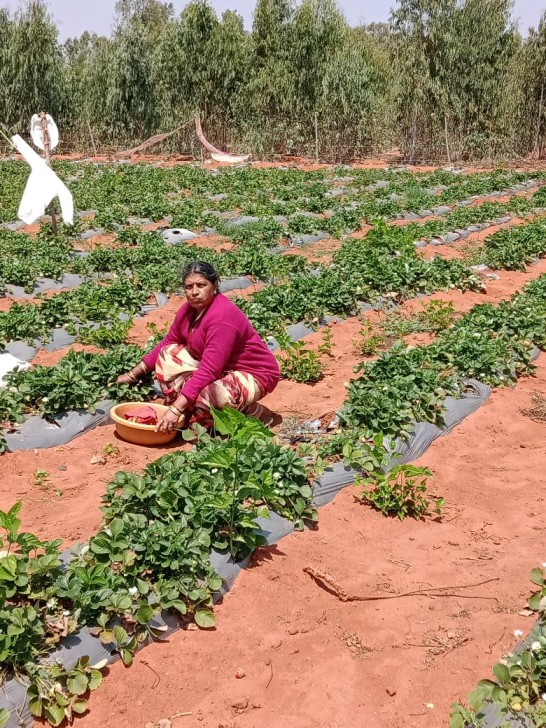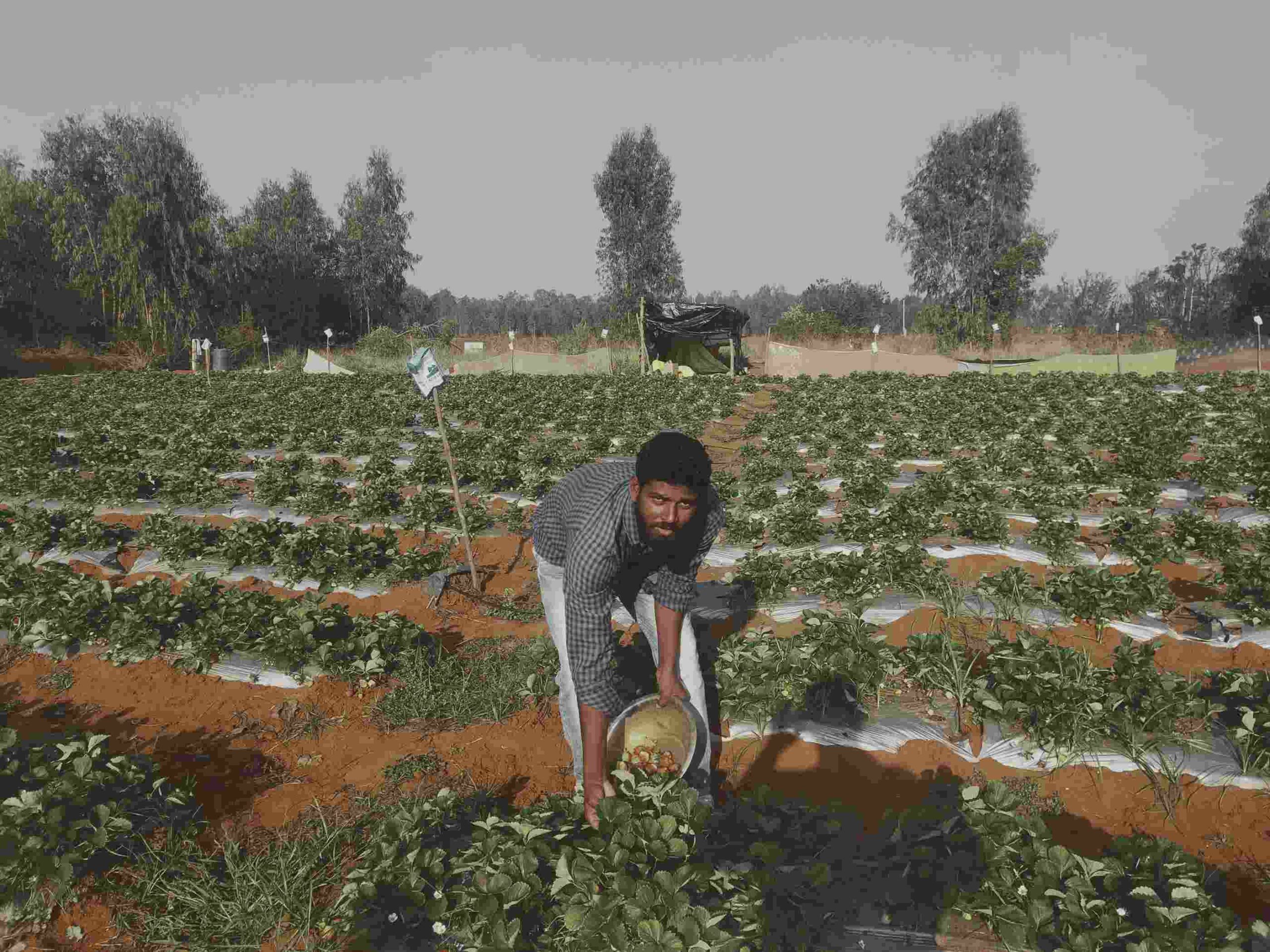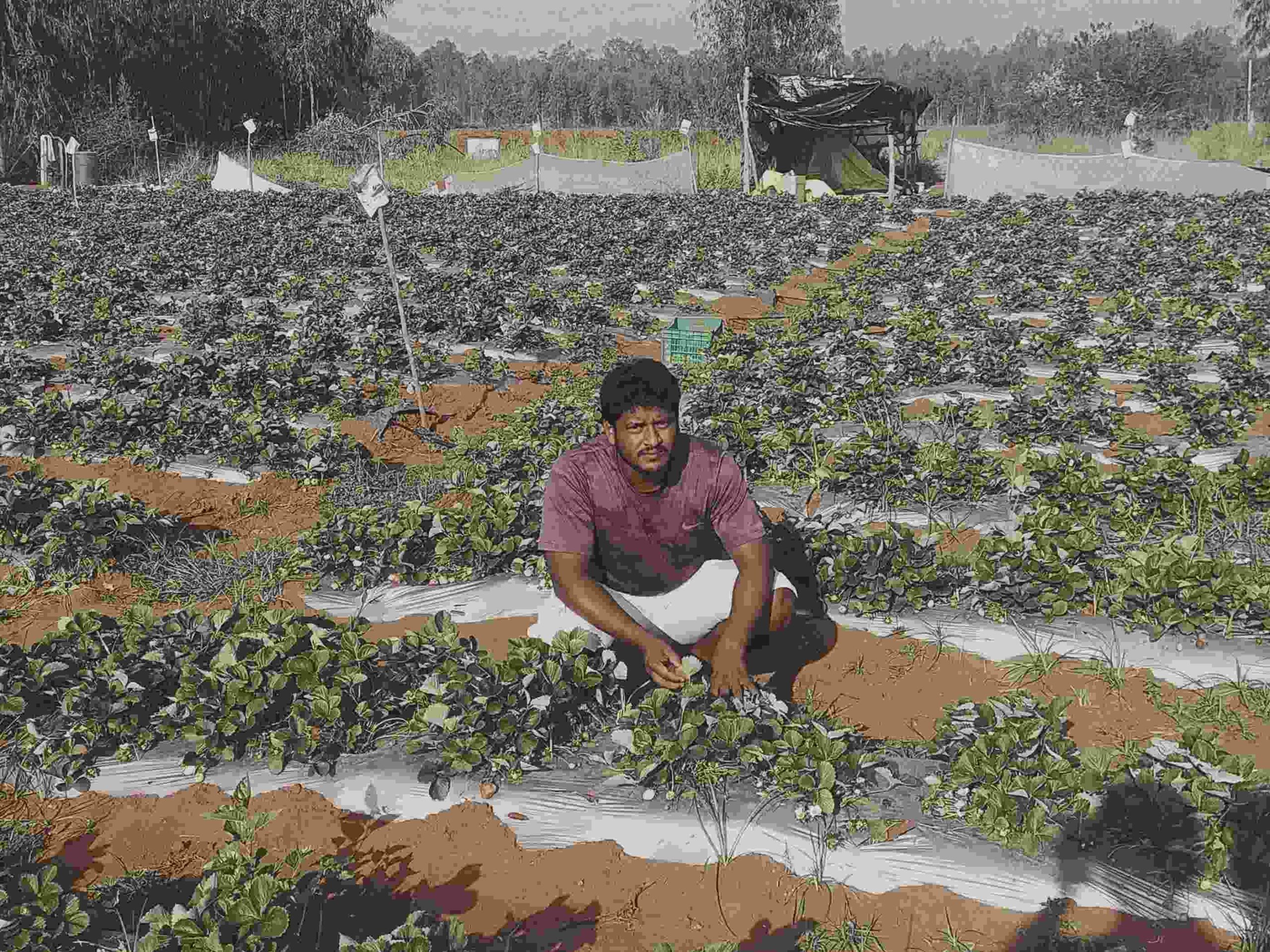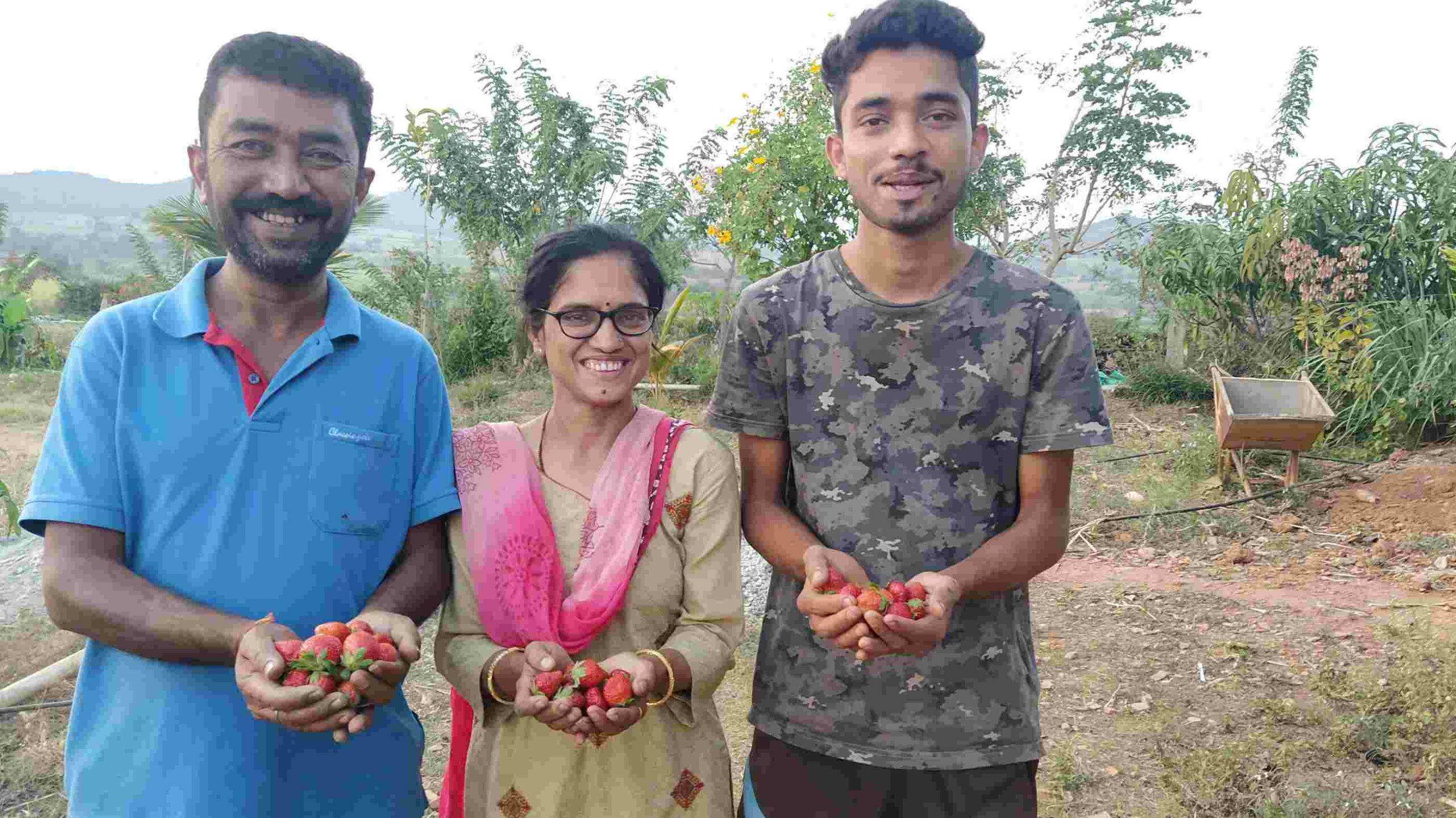Gifted with a fertile dry agricultural land, Dharwad in north Karnataka has been known for its jowar, cotton, safflower or vegetables like brinjal, chilli, tomato, methi, dill and fruits like mango, guava, sapota, etc. The temperate climate of the region suits these crops.
But since mid-2019, things have started changing.
For the last two seasons, strawberry, a new fruit to the region, is tentatively making its presence felt. As you walk down on the busy main Subhash Road of the Dharwad city or many roads in its twin city Hubli, you will be surprised to see street vendors selling small boxes of strawberry. The oldies ignore them thinking it to be some alien fruit whereas those over 25 devour them.
Even as you drive down from the city of Dharwad, especially on the winding narrow roads crossing villages and small hamlets like Gamangatti, B Hulikatti, Hullambi, Hindssageri, Tumarikoppa, etc. you will suddenly notice a half an acre or one acre of plot covered in strips of blue plastic sheets. They are mulching sheets, with holes punched at regular intervals. Small green leafy shrubs shoot out from these holes and playing peek-a-boo in the shrubs are the bright red heart shaped strawberries.
Joining hands with their northern counterparts are few villages even in south of Karnataka. Places like Chikkaballapur, Rajanukunte near the city of Bengaluru otherwise known to grow only grapes, grains or cultivate silkworms, are slowly growing strawberries. They are even supplying to big marketing groups like BigBasket, Reliance, etc.
The experimental farmers
The older generation of traditional farmers had never thought of growing the tropical fruit in this temperate region attached as they were with millets and vegetables. This red, luscious, delicate and weather-sensitive fruit till so far was considered an outsider but not any more. This definitely doesn’t imply that within a year, Karnataka has reached the map of strawberry growing states like Maharashtra, Uttar Pradesh, Punjab, West Bengal or Rajasthan. But looking at the young brigade of farmers willing to experiment and take a chance in growing this fruit might make the state a potential strawberry hub.
What is exciting to the young farmers—many of whom are fourth or fifth generation farmers—is that they suddenly seem to discover many other products which they can grow. They talk about red cabbage, dragon fruit, broccoli, zucchini, iceberg lettuce, red-yellow bell pepper and whatever else that is clubbed under exotic veggies and fruits.
“It’s too soon to say if this is going to be the norm,” says Geeta Tamgale, a scientist at the Home Science Department in the University of Agriculture Science, Dharwad. “But few farmers have started this and they even approach our department to prepare jam from the extra produce of fruits.”
The reason for this experiment with new crops, according to former principal of engineering colleges, Dr Prakash Hubbali, who owns more than four acres of farm in the village Hindssageri in the Kalghatgi taluka of Dharwad district, is that now “more and more educated people are getting into farming and as they are exposed to the news, information, social media and YouTube channels, they are willing to experiment by utilising a small portion of their farm land”.

He practices integrated farming, and though his strawberry crop this time got mercilessly attacked by pests, he is happy with his harvest of exotic veggies, especially zucchini.
The dawn of a new decade
Another factor that is helping the fruit to set its foot is the growing number of big names of industries and educational institutes. The IIT Dharwad was established in 2016. Today, there is a Software Technology Park, Tata Motors, Telco and many more in the area. With all these activities, the twin city of Dharwad-Hubli is getting exposed to lifestyle and food habits from the outside world.
“More than anything else, it was the pandemic and difficulty in getting a good job even after an MBA degree that made me try this experiment of growing strawberries in about half-an-acre land of our family farm which all these years harvested only corn, soyabean, etc,” explains 25-years-old Ravi Managundi of Gamangatti, near the cancer hospital off Dharwad-Hubballi Road.
He had planted only 6,000 runners, or saplings of strawberry, at the end of September 2020 and by December he started harvesting nearly 60 kgs of strawberry on alternate days. Now, at the end of the season, the quantity of fruits has come down to 10-12 kilos but Ravi is very happy with his experiment.
The success of planting just 6,500 runners of strawberries and getting more than 700 kilos of the fruit this year has made Manjunath Habib of B. Hulikatti village in Kalghatgi taluka think of expanding. “This year I had used only 10 gunta land. Next year I am planning to expand it to two acres and want to grow even broccoli, red cabbage, etc. With our borewell, it is easy to drip-irrigate our land,’’ says the 40-years-old jewellery shop owner.
According to Dr Prakash, marketing the product is a problem in this region. “We have to think of freezer containers to transport our produce otherwise it will be difficult to compete with our nearest strawberry growers from Mahabaleshwar.”

But the mother-sons trio of Chikkaballapur, near Bengaluru, don’t have the problem of marketing. They have tied up with retail marketers like Bigbasket and Reliance in the nearby Garden city. At the peak time, they harvested more than 80 kgs a day of strawberry fruit which has now at the end of season come down to about 40 kgs a day.

With mother Rathnamma, the brother duo Smithan (25) and Dhananjay (27) are game to try newer crops. Smithan, who works as a medical representative, says, “Besides some exotic veggies we also want to plant mulberry and rose apple. But first we will be attending one more workshop with Shashidhar Goravar of Hullambi in Kalghatgi. He is our mentor’’.

Shashidhar and his wife Jyoti are the pioneers of this trend in the state. As Shashidhar laughingly says, “It’s the red colour attraction!” Very happily and proudly the couple and their son, Surja, talk about their life and experiment with growing the fruit and propagating the idea in their region. They also successfully grow golden berry, red cabbage, and next on their agenda is mulberry.
The farm located on top of a hillock in the village nearly matches the climatic conditions of Mahabaleshwar. Having worked for more than two decades in Mahabaleshwar, first on the construction site and then on the strawberry farms, the couple mastered the complete technique.

After contacting the main suppliers of strawberry runners in California, the family set up the farm in Hullambi. Every strawberry grower we spoke to get the runners from Shashidhar. Fresh runners need to be planted every season. The couple are hands-on teachers. Anyone who buys the ‘saplings’ from them also get to attend a workshop, and Shashidhar goes to their farms to help them replant as well as guide them to take care of the plants. Plus he helps them to market their produce.
“The pandemic caused big problems for our sale. So we approached the Home Science department of University of Agriculture Sciences, Dharwad and they helped us in making and bottling not only strawberry jam but also the golden berry jam,” explains Jyoti, making us taste the golden berry jam.
Shashidhar claims that some 1500 to 2000 farmers are already in contact with him to learn and grow the ‘red hearts’. If they all start and succeed, then this decade will change the scene of farming in the state of Karnataka.
(Edited by Yoshita Rao)
No comments:
Post a Comment